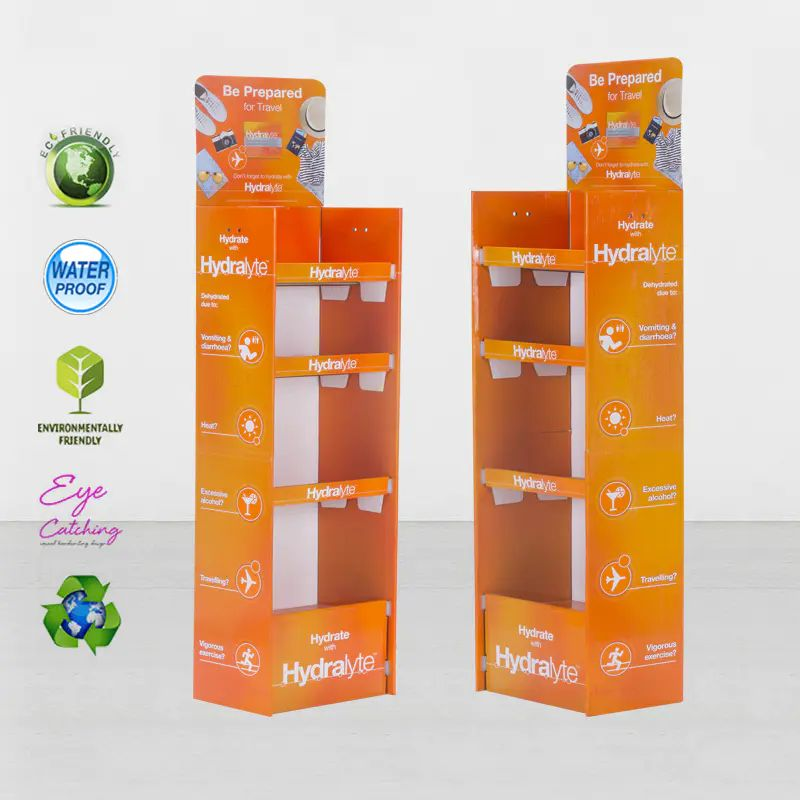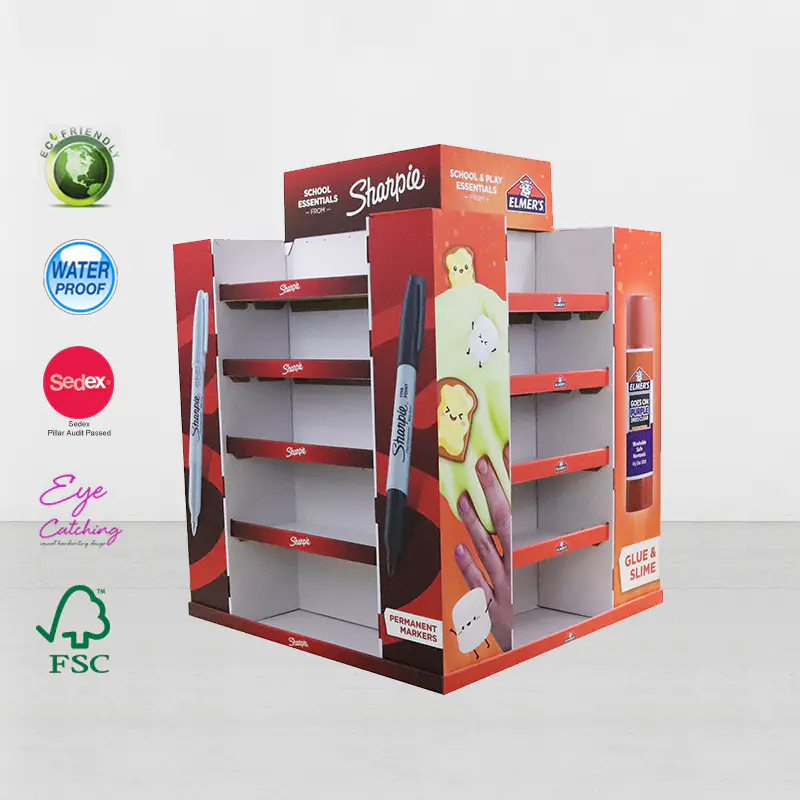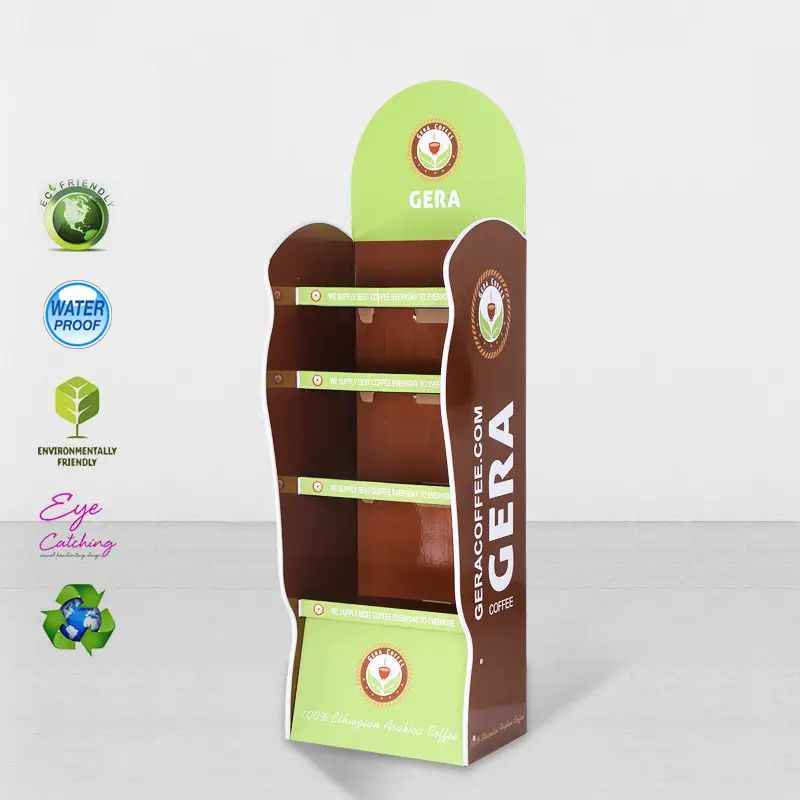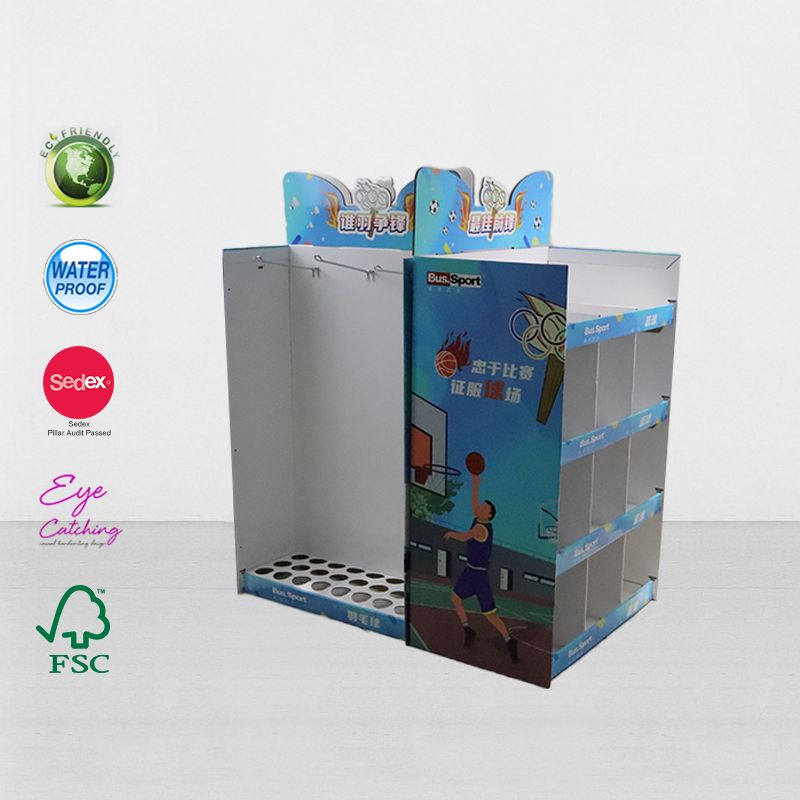In modern retail, display racks are not only tools for displaying merchandise but also crucial vehicles for boosting sales and optimizing the consumer experience. Among the many display formats, floor displays and pallet display racks are widely used due to their convenience and practicality.
However, many retailers are often confused when choosing between cardboard floor displays and pallet display racks: What exactly is the difference between cardboard floor displays and pallet display racks?
This article will provide a professional analysis of various aspects, including material, design structure, load-bearing capacity, display effectiveness, transportation, and installation methods, to provide clear reference for the retail industry.
What is a floor display rack?
A floor display rack, also known as a cardboard floor display, is a freestanding display rack placed directly on the ground. Made primarily of corrugated or composite cardboard, its precision design allows for stable support and multi-layer merchandise display. Floor displays are commonly used in retail environments such as supermarkets, convenience stores, and shopping malls, often for promotional events, new product launches, or seasonal product displays.
Key Features:
• Can be placed directly on the ground without the need for a pallet or additional support.
• Lightweight, making it easy to transport and relocate.
• Customizable branding on the printed surface enhances visual merchandising.
• Low unit cost, suitable for short-term promotions.

What is a pallet display rack?
A pallet display rack is a product display rack designed based on pallets, leveraging their load-bearing and handling properties. Pallets are typically made of wood, plastic, or metal, and the display rack can be stacked or frame-like. Pallet display racks are widely used in warehouse-style stores, large supermarkets, and logistics distribution centers, suitable for the rapid placement and handling of bulk merchandise.
Key Features:
• Stable support from pallets, offering a strong load-bearing capacity.
• Easy to transport with forklifts and hand trucks, improving storage and display efficiency.
• Allows for displaying entire cases of merchandise, reducing unpacking.
• More suitable for long-term displays and large-scale merchandise.

Cardboard Floor Display vs. Pallet Display Rack: Material Differences
Floor display racks are typically made of corrugated cardboard or composite cardboard. Their advantages include lightness, environmental friendliness, printability, and ease of recycling. Cardboard can be folded and spliced to create a stable structure, but its physical properties limit its load-bearing capacity.
Pallet display racks are primarily made of pallets, such as wooden, plastic, or metal pallets. These pallets are sturdy and durable, capable of supporting the display of heavy merchandise for extended periods. Pallets typically have a flat surface, making them easy to stack and carry, and they also offer resistance to humidity and friction.
Summary of the material differences:
Display rack types | Materials | Advantages | Limitations |
| Floor display racks | Corrugated cardboard/composite cardboard | Lightweight, printable, and environmentally friendly | Limited load-bearing capacity, average durability |
| Pallet display racks | Wooden/plastic/metal pallets | Strong load-bearing capacity, high durability, and easy to transport | High cost and heavy weight |
Cardboard Floor Display vs. Pallet Display Rack: Design and Structure Comparison
1. Design Features of Floor Display Racks
Floor display racks typically feature a vertical, multi-layer structure, with the number of layers adjustable based on product size and display requirements. Their design emphasizes the following aspects:
• Stability: A stable structure is ensured through strategic folding, splicing, and a reinforced base.
• Visual Merchandising: Surface printing can highlight branding and promotional information.
• Modularity: Removable and foldable, making them easy to transport and store.
2. Design Features of Pallet Display Racks
Pallet display racks prioritize load-bearing capacity and ease of handling. Key structures include:
• Pallet base: Ensures overall stability and can support the weight of an entire case of merchandise.
• Frame or stacking structure: Merchandise can be stacked in layers for easy forklift access.
• Flexible combination: Pallets can be combined with different types of racks for flexible display.
Design Structure Comparison Table:
Features | Floor Display Stand | Pallet display rack |
| Support Method | Free-standing | Pallet support |
| Number of Layers | Customizable | According to pallet specifications |
| Stability | Medium-sized, requires reinforcement | High, pallet-based |
| Portability | Lightweight, but requires manual handling | Supports mechanical handling |

Cardboard Floor Display vs. Pallet Display Rack: Load Capacity
Floor display racks are suitable for light or medium-weight merchandise, such as food, cosmetics, and daily necessities. While cardboard is lightweight, its load capacity is limited, making it unsuitable for heavy or fragile items.
Pallet display racks, on the other hand, can carry entire cases or large items, with a load capacity ranging from tens to hundreds of kilograms, making them ideal for bulk merchandise display and warehouse environments. Pallet display racks offer a variety of display options, including displaying entire cases or displaying in separate layers.
Cardboard Floor Display vs. Pallet Display Rack: Display Effect
Due to the flexible nature of the material and surface printing, floor display racks are suitable for branding and promotional activities. Their design can highlight product selling points and draw consumer attention. For example, printing large product posters, using colored baseboards, or adding uniquely shaped design elements can effectively enhance product appeal.
Pallet display racks prioritize efficiency and a sense of volume. They're suitable for visually displaying whole cases or large items, creating a more warehouse-like and industrial aesthetic. However, their branding effectiveness is weaker, and they often require supplementary signage or hanging banners.
Cardboard Floor Display vs. Pallet Display Rack: Transportation and Installation Methods
1. Floor Display Rack
• Transportation: Foldable for transport, saving space.
• Installation: Lightweight and easily assembled manually, typically by plugging and folding.
• Suitable for: Temporary promotions, holiday events, pop-up stores, etc.
2. Pallet Display Rack
• Transportation: Pallet-based, transportable by forklift or cart, offering high efficiency.
• Installation: Pallet-based, stacked, and typically handled manually or mechanically.
• Suitable for: Large supermarkets, warehouses, logistics distribution, and long-term displays.
Transportation and Installation Comparison Table:
Project | Floor Display | Pallet Display Rack |
| Transportation Method | Labor | Manual/Mechanical |
| Transportation Efficiency | High, Foldable | High, suitable for full pallet transport |
| Installation Difficulty | Low | Medium, requires stacking or mechanical assistance |
| Applicable Time Limit | Short-Term | Long-term |
Cardboard Floor Display vs. Pallet Display Rack: Cost
Floor display racks are generally cheaper than pallet display racks, primarily due to their lightweight material and simplified processing, making them suitable for large-volume promotional use. Pallet display racks, due to their sturdiness, portability, and long-term use, are more expensive, but their long-term durability and load-bearing capacity can offset the initial investment.
Cost Factors | Floor Display | Pallet display rack |
| Material Cost | Low | High |
| Processing Cost | Low | Medium |
| Usage Lifecycle | Short | Long |
| Maintenance Cost | Low | Low/Medium |
Cardboard Floor Display vs. Pallet Display Rack: How to Choose?
"Caiyijie Printing" Recommendations:
1. Promotional and Brand Display: Floor display racks are more suitable for short-term promotional and branding events, offering flexible layout and enhanced visual impact.
2. Bulk and Heavy Goods: Pallet display racks are more suitable for large items, full cases of goods, and environments requiring mechanical handling, offering greater load-bearing capacity and durability.
3. Environmental and Space Considerations: Floor display racks take up less space and offer flexible layout, while pallet display racks are more suitable for large, open display areas.

Looking to buy high-quality cardboard displays?
Foshan Caiyijie Printing Co., Ltd., established in 2002 in Foshan, China, is a trusted manufacturer and supplier of customized cardboard display solutions. Covering an area of 20,000 square meters with a professional team of 180 employees, our factory specializes in Cardboard Floor Displays, Hook Displays, Pallet Displays, PDQ Display Boxes, Dumpbins, Sidekick Displays, Cutouts, and Large Packaging Boxes. We provide wholesale, low-price, and bulk purchasing options with excellent design, printing, and finishing quality.

